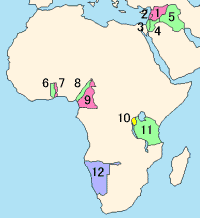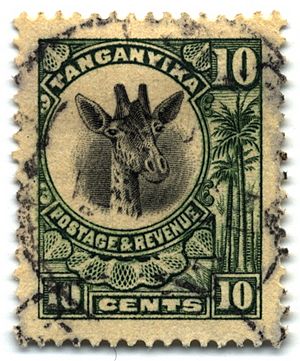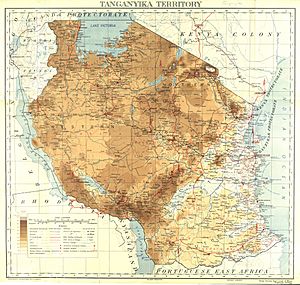Tanganyika Territory facts for kids
Quick facts for kids
Tanganyika Territory
|
|||||||||
|---|---|---|---|---|---|---|---|---|---|
| 1916–1961 | |||||||||
|
|
|||||||||

League of Nations mandates in the Middle East and Africa, with no. 11 representing Tanganyika
|
|||||||||
| Status | Mandate of the United Kingdom | ||||||||
| Capital | Dar es Salaam | ||||||||
| Common languages | English (official) | ||||||||
| Religion | Protestantism, Catholicism, Islam and others. | ||||||||
| Monarch | |||||||||
|
• 1916–1936
|
George V | ||||||||
|
• 1952–1961
|
Elizabeth II | ||||||||
| Governor | |||||||||
|
• 1916–1925
|
Horace Archer Byatt | ||||||||
|
• 1958–1961
|
Richard Turnbull | ||||||||
| History | |||||||||
| 1916 | |||||||||
|
• Mandate created
|
20 July 1922 | ||||||||
|
• Independence
|
9 December 1961 | ||||||||
| Currency | East African shilling | ||||||||
|
|||||||||
| Today part of | Tanzania | ||||||||
Tanganyika was a territory in East Africa that was controlled by the United Kingdom. This control lasted from 1916 until 1961. At first, it was managed by the military.
Later, starting on July 20, 1922, it became a formal League of Nations mandate under British rule. After 1946, the UK managed it as a United Nations trust territory.

Before World War I, Tanganyika was part of a German colony called German East Africa. During the East Africa Campaign, British and Belgian forces slowly took over the area. German forces kept fighting until 1918.
After the war, the League of Nations officially gave the UK control of the area. The UK then renamed it "Tanganyika." The UK held Tanganyika as a League of Nations mandate until the end of World War II. After that, it became a United Nations trust territory.
In 1961, Tanganyika became independent from the UK. It was then called Tanganyika. A year later, it became a republic. Today, Tanganyika is part of the country known as Tanzania.
Contents
What Does the Name "Tanganyika" Mean?
The name of the territory came from Lake Tanganyika, a very large lake in its western part. Henry Morton Stanley found the name "Tanganika" when he visited Ujiji in 1876.
He wrote that local people were not sure what it meant. He thought it might mean "the great lake spreading out like a plain" or "plain-like lake."
The British chose this name when the Treaty of Versailles was signed. This happened when Britain gained control of Tanganyika in 1920. Britain needed a new name to replace "German East Africa."
Many names were considered. These included "Smutsland" (after General Jan Smuts), "Eburnea," and "Windsorland." The Colonial Secretary wanted a "native name" linked to the territory. Names like "Kilimanjaro" and "Tabora" were suggested but not chosen.
Finally, "Tanganyika Protectorate" was suggested after Lake Tanganyika. A small change was made, and "Territory" was used instead of "Protectorate." This was because "Territory" fit better with the League of Nations mandate.
A Brief History of Tanganyika
The area of Tanganyika was often visited by Arabic traders. They came to buy slaves and ivory. The island of Zanzibar even became part of the Sultanate of Oman. This happened when Seyyid Said became ruler in 1806.
Oman's interest in Tanzania grew. In the early 19th century, Oman developed more in the region with British help. This was to stop French growth in the Indian Ocean. Trade routes went deeper into the continent, connecting the coast and the inland areas.
In some places, local people, like the Yao, adopted Islam. Islam is still a major religion in the area today. About 36% of Tanzanians follow Islam.
In the late 1800s, European explorers and colonialists traveled through Africa from Zanzibar. In 1885, the German Empire decided to create a protectorate there. It was called German East Africa (GEA), led by Carl Peters.
The Sultan of Zanzibar did not agree at first. German warships then threatened to attack his palace. Britain and Germany then agreed to divide the mainland into different areas of control. The Sultan had to accept this.
The Germans dealt harshly with the Maji Maji Rebellion in 1905. The German government also started an education program for Africans. This included elementary, secondary, and vocational schools.
How the Colony Developed
The German colonial government developed the colony in several ways. They grew valuable crops like cotton, sisal, cocoa, and coffee. These crops were important for German businesses and people.
Sisal was especially useful for making ropes. It was one of German East Africa's biggest exports. In 1893, there was only one sisal farm. By 1913, there were 54. By the end of 1913, the country exported over 20,000 tons of sisal. This made up 30% of all its exports.
To move these goods easily, several railways were built. The most important was the Central Line. This railway connected much of the country to the port city of Dar es Salaam. This railway is still used today. It has also been connected to other railways across the country.
British Control After World War I
After Germany lost World War I, GEA was divided among the winning countries. This was part of the Treaty of Versailles. Most of the territory went to British control. Only Ruanda-Urundi went to Belgium, and a small area called the Kionga Triangle went to Portuguese Mozambique.
The British named their part of the former German East Africa "Tanganyika." In 1927, Tanganyika joined the Customs Union of the East Africa Protectorate and the Uganda Protectorate. These later became the independent countries of Kenya and Uganda.
Cooperation grew between these areas. This led to the East African High Commission (1948–1961) and the East African Common Services Organisation (1961–1967). These groups were early versions of the East African Community.
Tanganyika held its first elections in 1958 and 1959. The next year, it gained the right to govern itself internally. New elections were held in 1960. The Tanganyika African National Union (TANU) won both elections. This party led the country to independence in December 1961.
In 1962, a presidential election was held. TANU leader Julius Nyerere won. In the mid-20th century, Tanganyika was the world's largest producer of beeswax.
British Policies and Changes
Britain took control of Tanganyika because of the Treaty of Versailles. Britain wanted Tanganyika to be a "Black man's country." They wanted it to be like Colonial Nigeria in its government structure.
As the rule in Nigeria changed to indirect rule, so did the rule in Tanganyika. The British also had an anti-German policy. This was led by Sir Horace Bryatt, the main official in Tanganyika. Bryatt was not popular. His policy of expelling Germans cut Tanganyika's European population in half.
Many former German farms were sold to European companies. Mixed farms were given to new British owners. Much of Tanganyika's economy was based on cash crops, especially coffee.
British rule did help the Asian community in Tanganyika. They were protected by Britain and were no longer attacked as they had been during the war. Many Asians from the Indian administration came to work for the Tanganyikan government. This caused the Asian population in Tanganyika to grow from 8,698 in 1912 to 25,144 in 1931.
The Road to Independence
One of the main groups pushing for independence in Tanganyika was TANU. It was founded in 1954 and led by Julius Nyerere. In 1963, TANU allowed all people in Tanganyika to join. Before that, only Africans could join.
TANU's success was clear in the 1958 election under colonial rule. TANU candidates, or those supported by TANU, won every seat. Most voters in Tanganyika were African. About two-thirds of the 28,500 registered voters were African. They came from all over the country.
Some British settlers resisted this. They formed the United Tanganyikan Party (UTP) in 1956, led by Brian Willis. However, this party became less important. It was clear that Nyerere and TANU would win the fight for independence. UTP was less effective partly because Willis had a high salary. This limited the money the party had for campaigning.
Tanganyika finally gained its independence on December 9, 1961. This happened after Nyerere met with a British government representative. They planned the steps for independence.
Notable People from Tanganyika
- Julius Nyerere (1922–1999): An activist, politician, and thinker who fought against colonial rule.
- Vasant Tapu (1936–1988): A Tanzanian cricketer.
- Ebrahim Hussein (born 1943): A Tanzanian writer of plays and poems.
- Clive Elliott (1945–2018): A British bird expert and international civil servant.
- Usha Sunak: A pharmacist and mother of Rishi. She was born in Tanganyika.
- Dudley Seaton (1953–1978): Son of Alberta Jones Seaton, a zoologist involved in African independence movements.
- Juma Mkambi (1955–2010): A Tanzanian football player.
- Tim Macartney-Snape (born 1956): A mountaineer and author.
- Kipruto Rono Arap Kirwa (born 1957): A Kenyan politician.
Tanganyika Becomes Independent
The British colony of Tanganyika became independent on December 9, 1961. Julius Nyerere became its first prime minister in 1960 under British rule. Then, when Tanganyika became a republic in 1962, he became president.
Nyerere was the main leader of the independence movement. He led the TANU party. This group included many different kinds of people who all wanted independence from Britain. TANU gained support by focusing on national issues.
For example, TANU talked about fears that the colonial government wanted to give too much power to European and Asian minority groups. This would have hurt the idea of Tanganyika being truly independent. TANU created a strong feeling among Africans that colonialists might still have power, even after independence.
Challenges After Independence
Tanganyika gained independence peacefully. However, it faced problems common to many new African countries. These included not having enough money and poor infrastructure (like roads and buildings).
Two main challenges for Tanganyika were its geography and its neighbors. Conflicts in nearby countries like Congo, Burundi, and Rwanda meant that many refugees came into Tanganyika. This large number of refugees was a big problem for Tanganyika so soon after independence. These challenges showed how insecure Tanganyika and its people felt.
Also, Nyerere focused more on modernizing the country and his African socialist idea called Ujamaa. This led to many rural farmers losing their way of life as large farms grew.
In 1964, after the Zanzibar Revolution (which ended Arab rule in Zanzibar), Tanganyika joined with Zanzibar. They became the United Republic of Tanganyika and Zanzibar. This country later became known as the United Republic of Tanzania on April 26, 1964.
See Also
 In Spanish: Tanganica (colonia) para niños
In Spanish: Tanganica (colonia) para niños
- List of colonial heads of Tanganyika
- Tanganyika groundnut scheme




